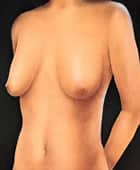Over the years, factors such as pregnancy, nursing, and the force of gravity take their toll on a woman's breasts. As the skin loses its elasticity, the breasts often lose their shape and firmness and begin to sag. Breastlift, or mastopexy, is a surgical procedure to raise and reshape sagging breasts--at least, for a time.
Mastopexy can also reduce the size of the areola, the darker skin surrounding the nipple. If your breasts are small or have lost volume--for example, after pregnancy--breast implants inserted in conjunction with mastopexy can increase both their firmness and their size.
The Best Candidates For Breast Lift
The best candidates for mastopexy are healthy, emotionally-stable women who are realistic about what the surgery can accomplish. The best results are usually achieved in women with small, sagging breasts. Breasts of any size can be lifted, but the results may not last as long in heavy breasts.
Many women seek mastopexy because pregnancy and nursing have left them with stretched skin and less volume in their breasts. However, if you're planning to have more children, it may be a good idea to postpone your breast lift. While there are no special risks that affect future pregnancies (for example, mastopexy usually doesn't interfere with breast-feeding), pregnancy is likely to stretch your breasts again and offset the results of the procedure.
All Surgery Carries Some Uncertainty And Risk
A breast lift is not a simple operation, but it's normally safe when performed by a qualified plastic surgeon. Nevertheless, as with any surgery, there is always a possibility of complications or a reaction to the anesthesia. Bleeding and infection following a breast lift are uncommon, but they can cause scars to widen. You can reduce your risks by closely following your physician's advice both before and after surgery.
Mastopexy does leave noticeable, permanent scars, although they'll be covered by your bra or bathing suit. (Poor healing and wider scars are more common in smokers.) The procedure can also leave you with unevenly positioned nipples, or a permanent loss of feeling in your nipples or breasts.
Planning Your Surgery
In your initial consultation for brast lift in Burbank CA, it's important to discuss your expectations frankly with your surgeon, and to listen to his or her opinion. Every patient--and every physician, as well--has a different view of what is a desirable size and shape for breasts.
The surgeon will examine your breasts and measure them while you're sitting or standing. He will discuss the variables that may affect the procedure--such as your age, the size and shape of your breasts, and the condition of your skin--and whether an implant is advisable. You should also discuss where the nipple and areola will be positioned; they'll be moved higher during the procedure, and should be approximately even with the crease beneath your breast.
The Surgery
The incision outlines the area from which breast skin will be removed and defines the new location for the nipple. When the excess skin has been removed, the nipple and areola are moved to the higher position. The skin surrounding the areola is then brought down and together to reshape the breast. Stitches are usually located around the areola, in a vertical line extending downwards from the nipple area, and along the lower crease of the breast.
Some patients, especially those with relatively small breasts and minimal sagging, may be candidates for modified procedures requiring less extensive incisions. One such procedure is the "doughnut (or concentric) mastopexy," in which circular incisions are made around the areola, and a doughnut-shaped area of skin is removed.
After Your Surgery
After your breast lift, you'll wear an elastic bandage or a surgical bra over gauze dressings. Your breasts will be bruised, swollen, and uncomfortable for a day or two, but the pain shouldn't be severe. Any discomfort you do feel can be relieved with medications prescribed by your surgeon.

Over time, a woman's breasts begin to sag and the areolas become larger.

Incisions outline the area of skin to be removed and the new position for the nipple.

Skin formerly located above the nipple is brought down and together to reshape the breast. Sutures close the incisions, giving the breast its new contour.

After surgery, the breasts are higher and firmer, with sutures usually located around the areola, below it, and in the crease under the breast.

If your expectations are realistic, chances are you'll be satisfied with your breast lift.
Within a few days, the bandages or surgical bra will be replaced by a soft support bra. You'll need to wear this bra around the clock for three to four weeks, over a layer of gauze. The stitches will be removed after a week or two.
You can expect some loss of feeling in your nipples and breast skin, caused by the swelling after surgery. This numbness usually fades as the swelling subsides over the next six weeks or so. In some patients, however, it may last a year or more, and occasionally it may be permanent.
Your surgeon will give you detailed instructions for resuming your normal activities. You may be instructed to avoid sex for a week or more, and to avoid strenuous sports for about a month. After that, you can resume these activities slowly.
For a breast lift in Burbank California contact board certified plastic surgeon Dr. Saul Berger
Content courtesy of PlasticSurgery.org